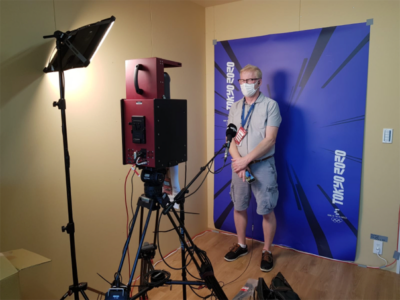As one of the leading global vendors of satellite communications services to clients in broadcast & media, law enforcement, public safety and defense, IMT Vislink was recently invited by Satnews Magazine to provide our view on the current state of the SATCOM industry—where we are now, the key trends driving the industry, and what is in store for 2019. Satnews is a leading publisher of satellite news, events, publications, research and other satellite industry information in both commercial and military enterprises worldwide. That story, contributed by IMT Vislink Product Manager David Edwards, appears below, and can also be read in its original PDF format at this link.
Note: The full suite of IMT Vislink SATCOM products can be viewed at this link.
Introduction: People on the edge of the SATCOM world have often viewed the industry as static and slow to change; however, when you are at the heart of the action, you can see the evolution and transformation that is occurring at an ever increasing pace.
 For an industry that relies on RF technology, there is a lot happening to integrate with the IP connected world. The rapid growth in High Throughput Satellite (HTS) capacity and the rise of Ka-band capacity is a testament to that, with some predictions suggesting a doubling of leasing revenues by the early 2020’s. There are major innovations going on in what has been termed New Space — Low earth Orbit (LEO) constellations that promise connectivity for locations that have always been a challenge for any form of reliable communication. This includes dependable, high bandwidth infrastructure for developing nations, polar regions and marine services.
For an industry that relies on RF technology, there is a lot happening to integrate with the IP connected world. The rapid growth in High Throughput Satellite (HTS) capacity and the rise of Ka-band capacity is a testament to that, with some predictions suggesting a doubling of leasing revenues by the early 2020’s. There are major innovations going on in what has been termed New Space — Low earth Orbit (LEO) constellations that promise connectivity for locations that have always been a challenge for any form of reliable communication. This includes dependable, high bandwidth infrastructure for developing nations, polar regions and marine services.
IMT Vislink is seeing transition and growth driven by humankind’s desire to experience more and better visual communication systems. 4K UHD resolution video is having an impact on TV broadcast services. Forward-looking statements of intent from many top-tier providers and high-end live events indicate that 2019 is likely to bring an increased demand for payload capacity and demand for antenna systems that fulfill the link budget requirements of higher bandwidth transmissions.
News programming is changing as well. News channels were once marketed and funded as halo services that stood clear as the identity of a broadcasting brand. Budget priorities have changed and operations leaders are investing in new ways to be more efficient in delivering on the insatiable appetite for news. Pre-recorded pieces to camera delivered as video files are becoming more common than live two-way interviews. There is a drive to procure more integrated and automated technology in a move to lessen the need for multiple highly skilled, highly specialized technical staff. Operational simplicity is most certainly the order of the day going forward.
Live TV broadcasting over satellite and other forms of connectivity continues to be driven by cost per bit economics. Uplink operators are keen to reduce their OPEX costs by investing in greater transmission efficiency — the company has been actively innovating this year to deliver that next step change.
 IMT Vislink has recently been showcasing a suite of new Advent products in the form of the DVE 6100 satellite encoder and IRD 6200 satellite decoder, that together provide end-to-end video connectivity and use new HEVC compression and DVB-S2X satellite modulation.
IMT Vislink has recently been showcasing a suite of new Advent products in the form of the DVE 6100 satellite encoder and IRD 6200 satellite decoder, that together provide end-to-end video connectivity and use new HEVC compression and DVB-S2X satellite modulation.
These two technologies combined offer up to a 50 percent reduction in satellite bandwidth compared to older technology, while maintaining equivalent quality video. For HD resolutions, the reduction in satellite bandwidth leasing and satellite bandwidth costs can result in a payback on investment in new equipment in just a few months. For operations that are dealing in 4K quality video, the new technology is the key that makes a service launch a practical reality.
It is not just the search for OPEX cost reduction where the new HEVC and DVB-S2X technology finds a home. By being more efficient in use of valuable bandwidth, broadcasters now have access to more payload data rate without transmission cost increases. This new space enables the broadcasters to satisfy the demand for additional content, like companion device content, commentary tailored to highlight a particular team and backstage interviews that all become affordable and deliver a more engaging production.
The Advent DVE encoder and IRD decoder products have developed a strong following in the SATCOM world by mixing high-quality video compression with low latency processing, which is extremely valuable when communication channels inevitably incorporate a geostationary round-trip. The small form-factor and integrated HPA control capability delivers valuable space-savings in increasingly sophisticated uplink vehicles or for fly-away applications that have to comply with airline baggage regulations.
Where does the IP world come in? In short, everywhere — IP internet connectivity between equipment is preferred as it leads to common interfacing, lower cost installations and for mobile operations, a valuable reduction in weight. New standards for video interconnection are now here and 2018 saw the beginning of SMPTE 2110 as a mechanism to transport baseband video over IP with the first all-IP video production trucks being brought into service. 2019 looks like it will be the year that many operators follow suit and finally transition to all-IP internal connectivity.
IP is increasingly critical on the external communication side too. In today’s hyper- connected world, it is unrealistic to expect remote and mobile teams to be beyond reach of IT network connectivity. For newsgathering and outside broadcast satellite transmission operations, if there is go-anywhere satellite connectivity, why not simplify operations by providing go-anywhere satellite connectivity to the corporate network?
This year, IMT Vislink has been responding to this need with a brand new Advent satellite terminal with IP at its heart. The AirPro75Ka antenna offers high rate IP connectivity that allows ad-hoc connection to the Eutelsat Konnect (formally Tooway) network.
The Advent AirPro75Ka terminal is a single-click device that automatically finds the satellite and provides users on-air connectivity in a matter of minutes. The antenna system uses pay-as-you-go data bundles for general connectivity and file transfer in conjunction with the ability to book uncontended satellite time to enable live and reliable broadcasts.
The Advent AirPro75Ka antenna has been finding many fans in the SATCOM industry by addressing the need of operators to work in newer and smarter ways with better use of budgets. The Ka-band IP connectivity provides better flexibility, better price per bit and a physically smaller antenna package than traditional Ku-band terminals, which allows it to be installed as a companion antenna on existing DSNG trucks or as a sole transmission device on new smaller vehicles.
Having tested the market response to the device this year, conducting data transmission trials, including on environmentally friendly electric vehicles, not only are customers liking the robust affordable construction, they are also liking that IMT Vislink is selling the antenna and air-time as a combined package. Selling both the antenna and air-time in a package is enabling a quick and easy transition to the IP connected world. This is something IMT Vislink will be taking to the mass-market in the coming year.
With such a heavy investment and commitment to the SATCOMs industry, IMT Vislink is reaffirming the long-standing Advent satellite brand. Users taking delivery of new satellite products in 2019 will notice improved user interfaces and a fresh modern logo that reflects the dawning of a new IP-centric satellite world.
To get additional information about IMT Vislink SATCOM solutions, contact us at sales@vislink.com.




